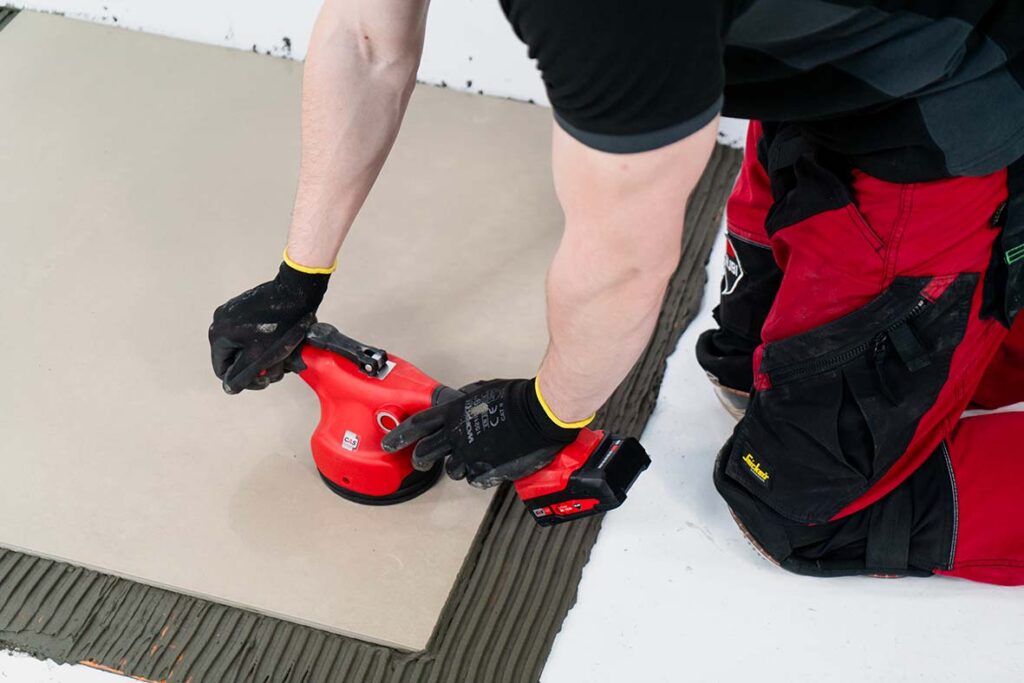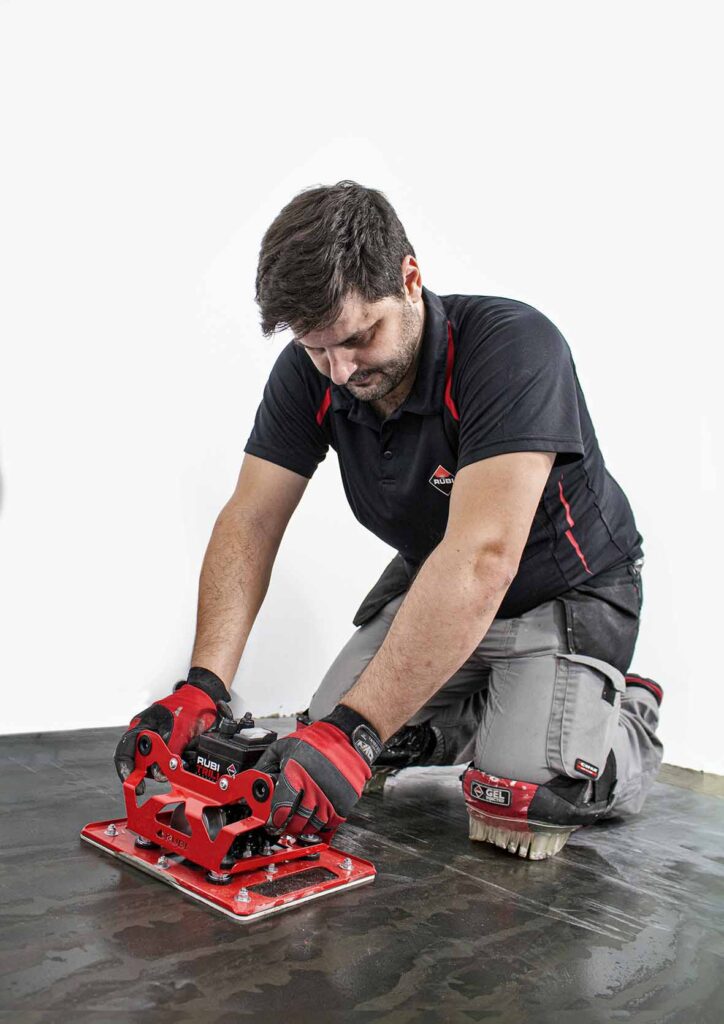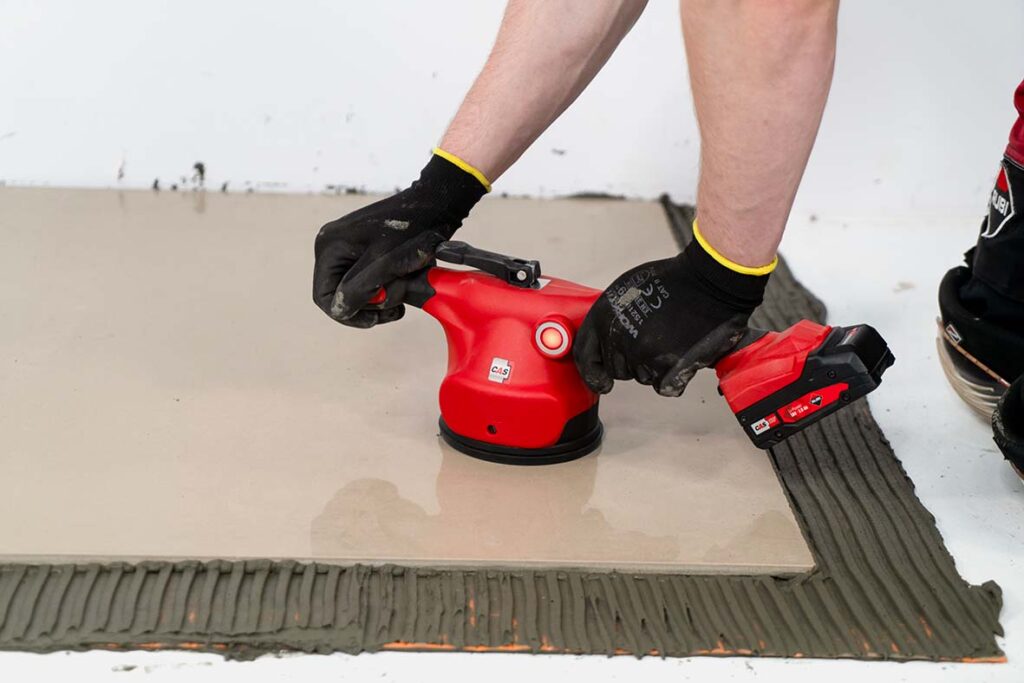Tile installation has seen significant advancements over the years, with modern tools making the process more efficient and effective. One such innovation is the tile vibration tool, which has become more present in professional tile installations. In this blog, we will explore how to tile with these new tools, their functionality, and the numerous benefits they offer.


Understanding Tile Vibration Tools
A tile vibration tool, also known as a tile thumper, is a specialised device used in the installation of tiles. It is designed to help evenly spread the adhesive beneath the tiles and eliminate air pockets, ensuring that the tiles adhere properly to the substrate. Here at RUBI we offer two types of tile vibration tools: Our Quake Energy CAS is a small, handheld battery operated unit, whereas our Triller is a larger unit, designed for large format, and come in a corded or battery version.
Functionality of Tile Vibration Tools
The primary function of a tile vibration tool is to apply consistent vibrations to the tile surface after they have been laid on the adhesive. Here’s a step-by-step guide on how to use them.
- Placement of Tiles: Once the adhesive is applied to the substrate, tiles are laid in their designated positions.
- During Use: The tile vibration tool is then placed on the tile surface. For handheld models, the user can easily control the tool, while larger machines cover a broader area.
- Vibration Mechanism: The tool generates vibrations, which are transmitted to the tile surface. The intensity and frequency of these vibrations can be adjusted according to the needs of the specific project.
- Distribution of Adhesive: The vibrations help spread the adhesive evenly beneath the tiles, ensuring full coverage and strong adhesion.
- Elimination of Air Pockets: Air pockets trapped beneath the tiles are a common issue that can lead to weak spots and tile lifting over time. The vibrations help eliminate these pockets, creating a more durable bond.
- Leveling: The tool also assists in leveling the tiles, reducing the need for manual adjustments and ensuring a uniform surface.
Benefits of Using Tile Vibration Tools
Using a tile vibration tool offers several advantages for the tiler, while also enhancing both the quality and efficiency of tile installation. Here are some key benefits:

1. Improved Adhesion
One of the most significant benefits of using a tile vibration tool is the improved adhesion of tiles. By ensuring that the adhesive is evenly spread and free of air pockets, these tools create a strong bond between the tile and the substrate. This reduces the risk of tiles lifting or shifting over time, leading to a longer-lasting installation.
2. Enhanced Durability
Proper adhesion directly impacts the durability of the tiled surface. Tiles that are firmly adhered are less likely to crack or become dislodged, even under heavy foot traffic or other stresses. This durability is especially important in high-traffic areas such as kitchens, bathrooms, and commercial spaces.
3. Time Efficiency
Tile vibration tools significantly reduce the time required for manual adjustment and levelling of tiles. The vibrations quickly settle the tiles into place, allowing installers to move on to the next section of the project more rapidly. This increased efficiency can lead to shorter project timelines and lower labour costs.

4. Consistency
Achieving a consistent finish is crucial for professional tile installations. Tile vibration tools ensure that each tile is uniformly adhered and levelled, resulting in a smooth and aesthetically pleasing surface. This consistency is difficult to achieve with manual methods alone.
5. Reduced Risk of Mistakes
Manual tile installation can be prone to errors, such as uneven adhesive application or misalignment of tiles. Tile vibration tools minimize these risks by automating the process of adhesive distribution and levelling. This leads to fewer mistakes and a higher-quality end result.
6. Versatility
Tile vibration tools are versatile and can be used with various types of tiles, including ceramic, porcelain, and natural stone. They are also suitable for different adhesive materials, making them a valuable tool for a wide range of tiling projects.

7. User-Friendly
Modern tile vibration tools are designed with user convenience in mind. They are typically lightweight, easy to handle, and come with adjustable settings to suit different project requirements. Even those with limited tiling experience can benefit from the use of these tools.
They also reduce strain put on your shoulders, back, and arms from traditional methods of bedding tiles into adhesive.
8. Cost-Effective
While there is an initial investment in purchasing a tile vibration tool, the long-term benefits often outweigh the costs. The reduction in labour time, decreased risk of mistakes, and improved durability of the installation all contribute to cost savings over time.
Choosing the Right Tile Vibration Tool
When selecting a tile vibration tool, it’s essential to consider the specific needs of your project. Here are some factors to keep in mind:
- Project Size: For large-scale projects, a larger vibrating machine may be more efficient, such as our Triller.
- Tile Type: Ensure the tool is compatible with the types of tiles you are using.
- Adjustability: Look for a tool with adjustable vibration settings to cater to different adhesive types and tile sizes.
- Ease of Use: Consider the ergonomics and weight of the tool, especially for extended use.
- Durability: Invest in a high-quality tool that will withstand the rigors of multiple projects. Both our Triller and Quake Energy CAS come with a 3-year warranty.
Tile vibration tools have revolutionised the process of tile installation, offering a range of benefits that enhance the quality, efficiency, and durability of the finished product. By understanding the functionality of these tools and leveraging their advantages, both professional installers and DIY enthusiasts can achieve superior results in their tiling projects.
Incorporating a tile vibration tool into your toolkit is a wise investment that can pay off in terms of improved project outcomes and long-term satisfaction. Whether you’re working on a residential renovation or a commercial build, these tools can help you achieve a flawless tile installation that stands the test of time.



Post a comment